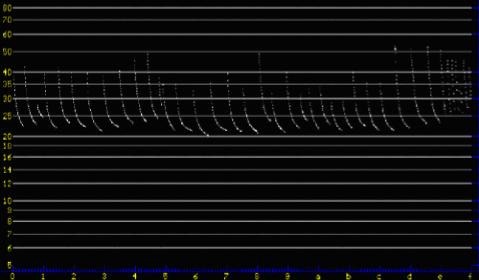Last updated: May 10, 2018
Article
Bat Inventory of Eugene O'Neill National Historic Site, John Muir National Historic Site and Point Reyes National Seashore

USGS / Paul Cryan
The Question
Which bat species are present at Eugene O'Neill National Historic Site, John Muir National Historic Site, and Point Reyes National Seashore? Which bat species utilize different habitats within Point Reyes National Seashore?
Bats are economically and ecologically important animals, providing ecosystem services such as pollination and predation of insects. Most bat species are difficult to study in the wild because of their nocturnal foraging and cryptic, inaccessible roost sites. In general, bat populations are believed to be declining. Most species have very low reproductive rates, producing about one offspring per year. Many species are also constrained by a limited number of specific roosting sites, despite large numbers of individuals in a population. These factors make recovery a slow process.
The declines are likely due to direct and indirect human impacts, primarily through destruction of foraging and roosting sites. The wildland-urban interface, or the intersection between wild and urban areas, is an important location for inventorying and monitoring of bat populations to determine the impacts of human development.
Biodiversity of bats in the U.S. is relatively low (45 species) in comparison to other taxonomic groups. The central coast of California is known to support 17 species from two families, nine of which have special status. All of these species are insectivorous, meaning they rely on insects as a primary food source.

NPS
The Project
Use acoustic sampling to conduct bat inventories in three San Francisco Bay Area Network parks.
Bats make ultrasonic vocalizations to communicate and echolocate prey. Researchers can record and analyze these calls using acoustic sampling methods. Acoustic sampling for this project utilized an Anabat II Detector System, which detects the ultrasonic echolocation calls and converts the signals into graphs on a computer. The graph of each call is unique, and can often be used to determine the species based on the frequency, shape, duration, and time interval of the call. Knowledge of the local bat ecology is necessary when analyzing acoustic data.
Acoustic sampling was conducted at Eugene O'Neill National Historic Site, John Muir National Historic Site, and Point Reyes National Seashore. All of these parks are on the wildland-urban interface. One station was installed at both Eugene O’Neill and John Muir. Eight stations were installed at Point Reyes, with one on the Golden Gate National Recreation Area North Unit (administered by Point Reyes) to target a range of habitats. At each station, Anabat II Detector Systems were installed and connected to a computer to collect data every night. Because this system required 24-hour access to 110-volt power, all sample sites were constrained to be on or near structures. Researchers checked the units and downloaded data at least once each month. One station at Point Reyes, the Bear Valley monitoring station, began operating in 1999. All other stations were installed in 2002. Some stations continued to collect data for over four years.
Results
Nine bat species were detected at Eugene O’Neill, John Muir, and Point Reyes. More species may be detected through alternate sampling methods. There were large differences in the number of calls detected at different sampling locations.
The differences in numbers of calls at different locations were likely due to the number of individual bats in the vicinity of the detector, and potentially the activity of a few bats that might be foraging (e.g., flying back and forth) in the vicinity of the detector. There were known bat roosts in the vicinity of the detectors at the Clem Miller Education Center (Point Reyes), Point Blue Conservation Science (Palomarin), and the Wilkins Ranch sites (Bolinas). Interestingly, there was almost certainly not a roost in the vicinity of the detector at Olema Marsh, which detected a fairly large number of calls.
| Park | Location | Days | Total # of Calls | Calls per Day |
|---|---|---|---|---|
| Eugene O’Neill | Maintenance barn | 386 | 327,640 | 848.8 |
| John Muir | Maintenance building | 423 | 223,960 | 529.5 |
| Point Reyes | Bear Valley | 714 | 552,367 | 773.6 |
| Point Reyes | Education Center | 472 | 1,849,923 | 3919.3 |
| Point Reyes | Learning Center | 299 | 93,023 | 311.1 |
| Point Reyes | North District Operations Center | 333 | 64,890 | 194.9 |
| Point Reyes | Olema Marsh | 424 | 459,052 | 1082.7 |
| Point Reyes | Point Blue (Palomarin) | 317 | 749,260 | 2363.6 |
| Point Reyes | Point Reyes National Seashore Association | 393 | 174,212 | 443.3 |
| Point Reyes | Shallow Beach | 383 | 208,728 | 544.9 |
| Point Reyes | Wilkins Ranch | 480 | 620,302 | 1292.3 |

| Scientific Name | Common Name | Special Status |
|---|---|---|
| Myotis lucifugus | Little brown myotis | ---------- |
| Myotis yumanensis | Yuma myotis | ---------- |
| Myotis thysanodes | Fringed myotis | FS, BLM, WBWG |
| Myotis californicus | California myotis | ---------- |
| Lasionycteris noctivagans | Silver-haired bat | ---------- |
| Eptesicus fuscus | Big brown bat | ---------- |
| Lasiurus blossevillii | Western red bat | FS, WBWG |
| Lasiurus cinereus | Hoary bat | ---------- |
| Tadarida brasiliensis | Mexican free-tailed bat | ---------- |
Additional Resources
Fellers GM. 2007. Acoustic Inventory and Monitoring of Bats at National Parks in the San Francisco Bay Area. Western Ecological Research Center, USGS. Point Reyes, CA.
Contact Information
Links
San Francisco Bay Area Inventory & Monitoring Network
Pacific Coast Science & Learning Center
USGS Western Ecological Research Center
San Francisco Bay Area Network Species Lists - Certified Species lists including residency, abundance, and native/non-native status.
Summary by the Pacific Coast Science and Learning Center, April 2006.
